50 years ago, Max Planck scientists were among the first to analyze lunar rock samples
When the astronauts of the Apollo 11 mission returned to Earth, they had almost 22 kilograms of rock from the surface of the moon in their baggage. Josef Zähringer from the Max Planck Institute for Nuclear Physics in Heidelberg was one of the first researchers allowed to analyze the material in the US. Two months later, Heinrich Wänke's team at the Max Planck Institute for Chemistry in Mainz also received a grain.
Text: Helmut Hornung

Thursday, September 18, 1969, late afternoon. At Frankfurt airport, a pale, tired-looking man gets off the plane. His name: Dr. Hans Voshage. His destination: the Max Planck Institute for Chemistry. In his carry-on luggage: 105.9 grams of moon. Value: priceless. Voshage now embarks on the final stage of his trip, the drive to Mainz. It is less than 48 hours since he left Mainz to jet off to Houston, Texas, to pick up the valuable cargo and bring it to Germany. On the evening of September 18, 1969, Voshage enters the institute where the impatient Director Heinrich Wänke and his staff are waiting for him. It takes only a few minutes for the scientists to begin with their first measurements. The second exploration of the moon commences.
Flashback: Sunday, July 20, 1969, 9:18 p.m. Central European Time. With its last drop of fuel, the Eagle lunar module touches down in the Sea of Tranquility. A few hours later, Neil Armstrong is the first human being to set foot on the moon, followed 20 minutes later by Buzz Aldrin. Six hundred million people watch the fuzzy television pictures that show two grainy figures skipping across the screen like kangaroos in slow motion. In the studios of the Westdeutscher Rundfunk broadcasting station in Cologne, Heinrich Wänke watches the screen. The scientist is one of the experts presenting the "giant leap for mankind" live on German television. Wänke is particularly excited as he watches events unfold, because his institute will be one of those permitted to conduct laboratory investigations on the lunar rock that the astronauts are collecting.
"NASA had invited tenders for the analysis of the samples. We took part - and were successful," recalls Heinrich Wänke. The researchers in his cosmochemistry department had gained an international reputation over many years through their investigation of meteorites. The American space agency likewise accepted the applications from scientists in Cologne and Tübingen. The Max Planck Institute for Nuclear Physics in Heidelberg was also among those chosen. Director Josef Zähringer was granted a particular honor: he was invited to Houston to collaborate on the preliminary evaluation of the material.
"The arrival of the Apollo 11 samples was very exciting"
On their return, the containers sealed on the moon were first irradiated with ultraviolet light and disinfected with peracetic acid before being rinsed in sterile water and dried in nitrogen gas. Only then were the researchers allowed to see them. "The arrival of the Apollo 11 samples was very exciting. The scientists had the problem of deciding who would be allowed to take the first historical look," wrote Zähringer in an article for the 1970 Yearbook of the Max Planck Society. "But when the sample container was finally opened and the rocks were visible for the first time, one could see only looks of disappointment. The rocks resembled a heap of coke. They were covered with a layer of very fine dust and it was not possible to recognize any mineralogical details.

"Nevertheless, the measurements were of historical significance and were conducted under unusual conditions: the researchers had to handle the samples in hermetically sealed glove boxes for fear of deadly moon bacteria or poisonous dust. There were some hitches: a torn glove and a burst supply pipe in the sample chamber. Those responsible at NASA were afraid that such occurrences would endanger the scientists and possibly contaminate them with germs. So they had to join the astronauts, who had been sitting in a transportable quarantine module since their return, and look at the world through a small window.
Josef Zähringer also had a little accident - so he, too, had to "go into quarantine." The Max Planck researcher took it in stride and even got something positive out of it: "The direct contact with the astronauts was a great advantage for identifying the rock samples, because they could answer many questions with information that was still fresh in their minds," he writes. Zähringer found the lunar explorers to be "normal, very nice and very humorous men." Despite the three weeks of isolation, the crew had their fun and spent their time playing poker.
Josef Zähringer, who died in a traffic accident in July 1970, had already taken a first scientific look at the lunar rock when Heinrich Wänke began his analyses on the evening of September 18, 1969. He wanted to investigate the composition of the material in order to settle questions about how the moon was formed, its age and the influence of the solar wind. "We were at the beginning of a new phase of moon research," says Wänke. And speed was of the essence: "The unstable radio isotopes increasingly decayed every day and thus became more and more difficult to measure." On October 10, the Max Planck Institute for Chemistry in Mainz received another 140 grams of the moon. Wänke's colleague Heinrich Hintenberger, head of the mass spectrometry department, took a very close look.
What was the code for the safe again?
The stuff planetologists' dreams were made of was not allowed to simply lie around in the laboratory. NASA had stipulated that the material was to be stored in a safe. The researchers in Mainz organized one and had it installed in Director Wänke's office. "The Americans didn't think much of locking it up with a key," says Wänke smiling, "It had to be a safe with a combination lock." Quite understandably, the scientists had more important things on their minds than this combination of numbers, and one day the slip of paper with the code was nowhere to be found - the safe had to be opened by a special company, with considerable effort …
So what did the researchers find out? "Give me a piece of the moon and I will tell you how our solar system was formed," said American Nobel laureate Harold C. Urey before the Apollo flights. This hope was in vain - not least because the rocks and dust from the surface are by no means pure primeval substance. On the contrary, the moon has been changed over the eons by smelting processes, so it is not the geologically primitive celestial body that most experts had believed it to be.
Earth's companion is scarred by craters that were created as cosmic lumps of rock impacted on its surface. Lava flows that had spread across the surface after particularly large fragments had collided with the infant moon formed the so-called seas. In addition, the permanent bombardment of smaller meteorites pulverizes the rock and covers the surface of the moon with a meter-thick layer of dust. This regolith contains not only sand grains, but also glassy inclusions. The researchers discovered that the samples contained a dozen minerals, above all pyroxene, plagioclase and ilmenite.
The most important question, however, was: How was the moon formed? An age determination of the lunar rock showed that it can't be much younger than the Earth, or around four and a half billion years old. Overall, the moon appeared to be very similar to our own planet: "It seemed to us to be a piece of the Earth," says Heinrich Wänke. The scientist used his investigations to derive the theory that the moon really does originate from our planet. The theory proposes that a celestial body the size of Mars struck primeval Earth with a sort of glancing blow. The collision ejected large amounts of material from the crust and mantle into orbit - where it formed the moon. "In the 1980s, computer simulations confirmed this scenario," says Wänke.
Fatal blow for conspiracists
And the researchers' analyses confirmed something else: the Americans really had been to the moon! Because in addition to the Apollo samples, the researchers in Mainz later also received material collected by unmanned Russian spacecraft. "The samples from both missions matched so well that this killed off the theory that the Americans had staged the landing in Hollywood studios - unless the Russians were in cahoots with them," says Friedrich Begemann, former Director of the isotope cosmology department.
Back to 1969: One clear evening in the fall, Heinrich Wänke returned from Begemann's office, where the two researchers had been grinding up lunar rock in a mortar. The full moon lit up the night sky. Wänke was looking at the Sea of Tranquility with the naked eye. Then he blew his nose - and stopped short: there in his handkerchief were two tiny dark grains - material from the moon, breathed in as he worked with the pestle. "That was frightening, because NASA insisted that every individual dust particle was to be accurately accounted for," explains Wänke with a grin. "After giving it a lot of thought, I decided not to record my findings after all. To this day the Americans don't know anything about this."
NASA, by the way, is the legal owner of the samples. The Max Planck Institute for Chemistry returned the last grains from the moon in fall 2008. In spring 2009, the space agency sent confirmation of their receipt.






